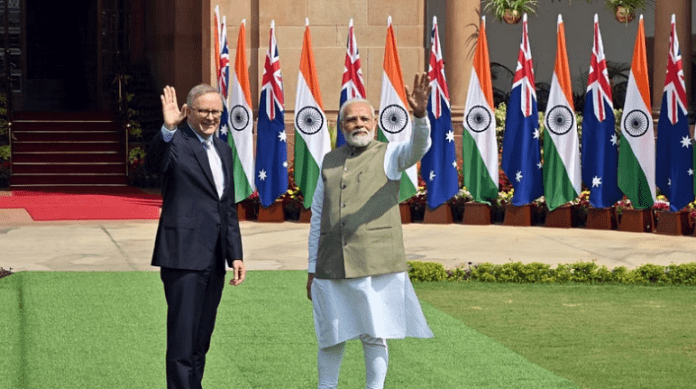The continuation of the Russia-Ukraine war has been a reminder of the fragility that exists in the world order. Unfortunately, we see a similar fragility playing out in the Indo-Pacific region, where Chinese aggression is impacting the littoral nations in the South China Sea as well as the Indian Ocean. For some time there has been a need for the world’s democracies to come together on a common platform to create conditions which obviate the need for war to settle disputes.
The fast-developing India-Australia relationship has been one of positive transformation in response to common challenges faced by the region. The relationship has, in the recent past, been revived to hitherto unknown heights including with a historic free trade agreement as part of the Quad format with the US and Japan. But what is less discussed is that India’s upwardly mobile ties with Australia are becoming the country’s gateway to a rejuvenated diplomatic push in the whole of the Pacific. Australia is the pivot to India’s move in the Pacific to counter Chinese interests.
The two countries are fine examples of important liberal democracies that are shaping the future of the region, based on their shared values for the rules-based international order and a free and open Indo-Pacific. The relationship has gone from strength to strength since the Modi government came to power in 2014. The Prime Minister is on his second official visit to the country now. In his first visit, he had said that “Australia will not be in the periphery of our vision, but at the centre of our thoughts.”
The bilateral meeting comes even as the Quad leaders’ summit has been cancelled. PM Modi’s visit to Australia has sent a strong message to counter China’s growing influence. To this end, PM Modi has even hinted at a “Look Pacific” policy reiterating the centrality of the India-Australia partnership in the Indo-Pacific.
However, it is interesting to note that this meeting comes in the backdrop of Australia-China relations thawing with trade ministers from both countries meeting in February 2023. Their relationship hit a roadblock in 2018 when Australia barred Chinese telecommunications company Huawei from building its 5G network. It was further damaged in 2020 when then Australian PM Scott Morrison called for an independent assessment of the origins of the Wuhan virus to which Beijing reacted very strongly with the threat of “economic coercion”.
It is apparent that China’s interests are pursued through the creation of economic pathways and India is perhaps the only country in a position to counter China’s economic movements not just in the smaller littoral states in the Indo-Pacific but also in Australia. India offers the balance that could crucially aid in maintaining a free and open region with Australia providing a dependable partnership.
After China’s April 2022 agreement with the Solomon Islands that would potentially establish a Chinese military presence in the region, PM Modi’s visit to Papua New Guinea is yet another step towards cementing relationships in the region. The move is likely to be welcomed by Australia. In 2018, Beijing offered to develop Papua New Guinea’s Lombrum naval base on Manus Island however the contract was awarded to Australia.
Though the bilateral meeting has many points of discussion for further strengthening the partnership, there would also be some difficult conversations. The issue of visa delays and student mobility with almost 70,000 Indian students in Australia, the issue of the vandalisation of Indian Consulates and temples such as the BAPS Swaminarayan temple, the rise of radical anti-India elements, hate crimes against Indians would all be topics of concern.

















